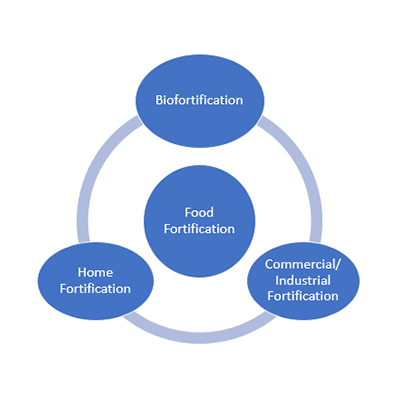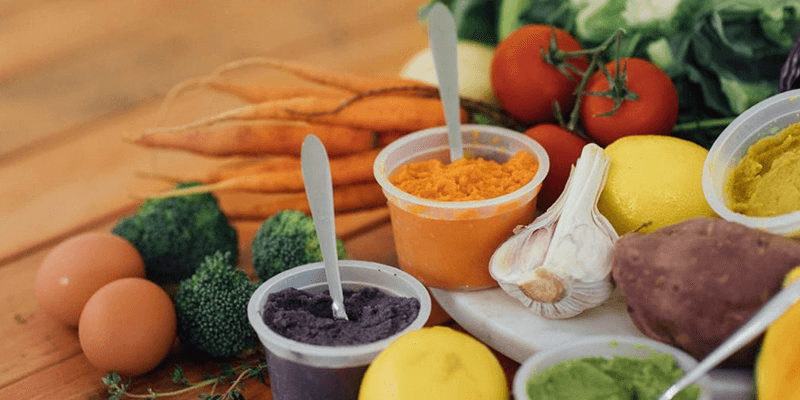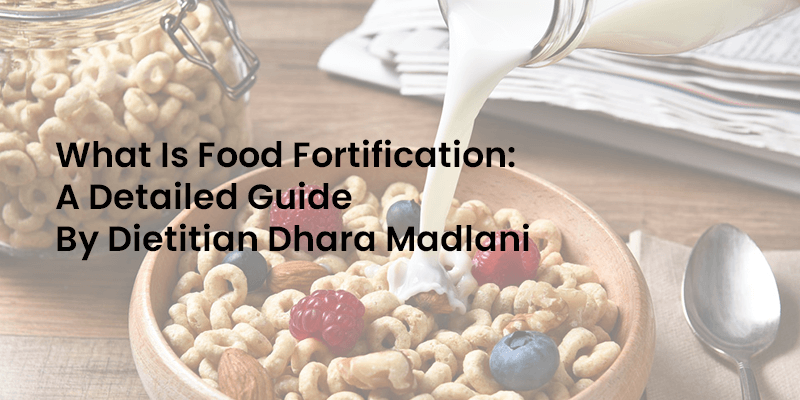Food fortification is a low-cost method that is good for health, the economy, and society. Even though there are ongoing debates about the effectiveness and safety of food fortification around the world and in some countries, the main ways that food fortification offers a lot of benefits. It includes things like reducing the number of people who don't get enough to eat and helping societies and economies grow. The World Health Organization says that food fortification is the practice of adding more essential micronutrients (vitamins and minerals) to food on purpose. This happens to improve the nutritional quality of the food supply and offer additional public health benefits without putting health at risk.
For instance, people can add iodine and iron to salt that people eat. You can also add other essential micronutrients to staples like rice, wheat flour, oil, and milk. The reason for choosing basic foods is to reach more people.
What’s Food Fortification?
Food fortification is used to increase the number of micronutrients in food or to replace nutrients lost when the food was processed. This helps to keep people from getting too few of certain nutrients in their diet.
Dietary deficits should be a thing of the past now that most Europeans have a huge range of foods to choose from. Some micronutrients are still very important, like iodine, folic acid, calcium, and vitamin D.
WHO and FAO have recognized food fortification as the second of four ways to reduce the number of people with nutritional deficiencies around the world. The FAO says that cereals and foods made from cereals, milk and dairy products, fats and oils, food add-ons, tea and other drinks, and formula for babies are the foods that are most often fortified. Undernutrition and not getting enough nutrients kills between 3 and 5 million people around the world every year.
Dietitian Dhara Madlani, who is the best dietitian in Ahmedabad, ensures in her diet plans that adding nutrients to meals can help you get what you need from your diet. You can get all of these nutrients from other foods, like meat and vegetables.
Conditions For Effective Food Fortification
Food fortification increases the supply of micronutrients by using the current delivery systems for industrially made goods. This makes sure that people don’t have too many nutritional gaps. The food vehicle determines how many people it can reach, but the effect depends on how many more micronutrients people eat and how big the nutritional gap is. Safety, the capacity of technologies to work together, and financial constraints frequently place limits on the level of fortification. Dietitian Dhara Madlani creates diet charts based on the information about the eating habits of the population residing in the specific region so that she can choose the fortification condition that has the best chance of succeeding.
Here are the criteria to follow:
- The nutrients obtained from the meal should be consumed in amounts that significantly alter the diets of those who need them. Stability depends on proper storage and use.
- There shouldn’t be any changes to the way the food looks or tastes (consumer acceptability)
- Most people should want to eat the fortified food because it should taste good.
- When you eat a vitamin, your body can use it.
- The food should be cheap enough so that people from all kinds of backgrounds can buy it.
Types of Food Fortification

There are two ways to use everyday foods as examples of fortified foods: by adding back and by adding. Some of their nutritional value is lost when grains are turned into flour. Iron, folic acid, niacin, riboflavin, and thiamine are re-added to flour to make it healthier. On the other hand, some fortified meals contain micronutrients that don’t naturally occur in those foods. The fact that orange juice is often offered with added calcium demonstrates this.
Furthermore, food fortification is classified into different groups based on when it is added:
Industrial Or Large-Scale Food Fortification:
LSFF, an abbreviation for “industrial or large-scale food fortification,” refers to food fortification in commerce and industry (corn meal, wheat flour, and cooking oils) (corn meal, wheat flour, and cooking oils). All processed foods, like salt, wheat, oil, sugar, and sauces, have micronutrients added to them.
These efforts are mandatory, in which case the government sets up and runs them, or voluntary, in which case food firms add nutrients to their goods on their own but must still obey the laws. More and more things, like iodized salt and fortified wheat, are subject to mandatory fortification programs.
Biofortification:
Biofortification is the process of growing crops to make them more nutritious. Breeding them to be more nutrient-rich achieves this. Most biofortification projects use plant breeding or agronomy to add iron, zinc, and provitamin A carotenoid to different food crops (mineral fertilizer). Some projects have also included protein and amino acids.
The goal of biofortification is to help poor families in rural areas that are hard to get to and don’t have access to foods that have been fortified by industry. Most of the time, these families make their living by farming. They can grow their own crops that are stronger and eat them or sell them. When done effectively, biofortification may assist food systems in providing healthier meals at a reduced cost.
Home Fortification:
Home fortification is the process of adding vitamins and minerals to cooked and ready-to-eat foods. Micronutrient powders are single-dose packets of vitamins and minerals in powder form that can be sprinkled on food without changing its taste or look.
For instance, the original “Sprinkles” brand was developed to treat anemia and iron deficiency by supplying iron and other minerals. Since then, the formulae have evolved to satisfy the diverse nutritional requirements of children under the age of five.
Benefits

- Maintains Nutrients In The Body:
Consuming fortified meals regularly is preferable to taking supplements sometimes. To assist those with inadequate diets, several micronutrients are added to meals at once.
Food fortification adds adequate quantities of micronutrients.
So, it is safer than vitamins and minerals. When controlled well, there isn’t much risk of long-term toxicity from fortification.
Despite the addition of micronutrients, food fortification has no influence on the flavour, aroma, texture, or appearance of the meal. For instance, fortified rice kernels (FRK) are produced by mixing rice flour with the necessary nutrients. Rice resembles FRK in terms of gloss, clarity, consistency, and flavour. Ordinary rice is combined with these grains.
- Affordable:
Food fortification is a cost-effective method for enhancing the nutritional status of people and is connected with substantial economic advantages. As the most cost-effective development intervention, micronutrient supplementation offers substantial benefits at a modest cost.
For instance, iodizing salt may cost as low as USD 0.05 per kilograms while wheat and maize fortified with iron and folic acid can cost as little as USD 0.12 per kilograms per year.
Food fortification of commonly consumed items might improve the nutrition of a large population, both poor and affluent. Fortification is often cheaper than other options, especially when the technology and food delivery infrastructure are already in place.
- Natural Or Near-Natural Micronutrients:
The elderly and pregnant women are particularly susceptible to vitamin deficiency. People on special diets must also be mindful of the possibility of nutrient deficits. Vegans, for example, might benefit from vitamin B-12 fortified diets.
In general, food fortification tries to give micronutrients in proportions that come close to those offered by a healthy, well-balanced diet. People with very low earnings have a range of micronutrient deficiencies.
In many developing nations, huge portions of the population may lack access to the foods necessary to meet their daily micronutrient needs. This may result in widespread nutritional shortages among the population.
The poor won’t obtain all the micronutrients they need via food fortification alone, even if it’s feasible. As a result, fortification foods example staple foods, will include natural or near-natural amounts of micronutrients, while supplements may not.
Drawbacks

- Doesn’t Help The Poor:
Due to restricted economic power and distribution networks, fortified foods rarely reach the poor. Micronutrient-rich foods, such as animal meals and fruits and vegetables, are scarce and inaccessible.
- No Substitute For Proper Nutrition:
Food fortification increases concentrations of certain micronutrients, but it’s not a substitute for a healthy diet with adequate calories, protein, vital fats, and other nutrients.
The type of the food carrier or fortifier may restrict the quantity of food fortification. For example, many iron supplements affect the color and taste of meals and cause breakdown of vitamin A and iodine.
- Greater Operating Expenses:
It’s possible that not everyone in a certain group eats a certain fortified meal. While everyone receives greater exposure to micronutrients in meals, regardless of need. Even while food fortification is less costly than other solutions, it still has significant expenditures. This could make it harder for developing countries to adopt and use food fortification programs.
- Not Recommended For Infants:
Recommended for the first six months of infancy is exclusive breastfeeding. A child can only get nutrition if the mother is healthy and eats the right kinds of foods. Pregnancy and lactation diet helps in this process. After six months, babies and toddlers start getting extra food, but they still only eat a small amount.
Conclusion
Some fortified meals are beneficial to your health. They might make up for what you wouldn’t get from food alone and give you more vitamins and minerals. But there can be an excess of something. Consult Dietitian Dhara Madlani for the right advice that some foods might give you too much of a certain nutrient.
According to Dietitian Dhara Madlani, inadequate nutrition cannot be compensated for by supplementing with vitamins. While enhanced and fortified foods may be a part of a balanced diet, they do not constitute a complete meal. You still need to eat a healthy, varied diet full of vegetables and other whole foods. You can’t get all the nutrients you need from fortification or enrichment alone. Dietitian Dhara Madlani is at the top of the search results for “dietitian near me” owing to her sound counsel. You can now book appointment here now.
Before you do a Google search, gather your own information, and start a new diet, you should talk to the best dietician in Ahmedabad to avail the best diet and nutrition services.
